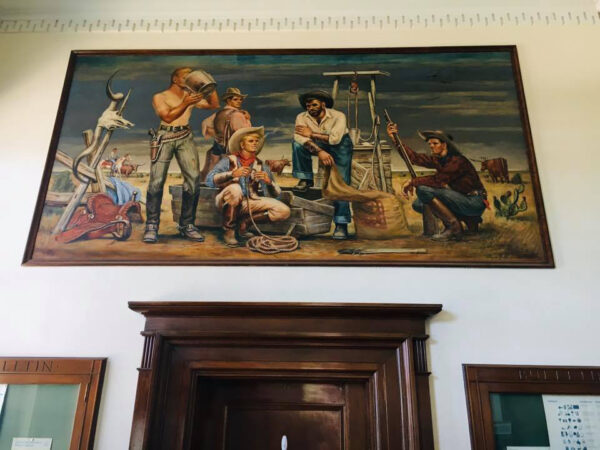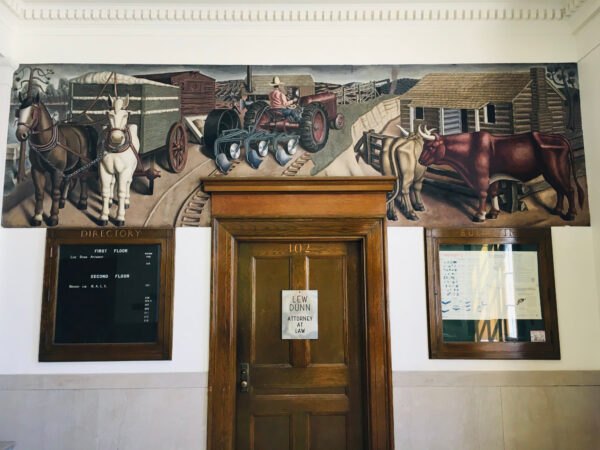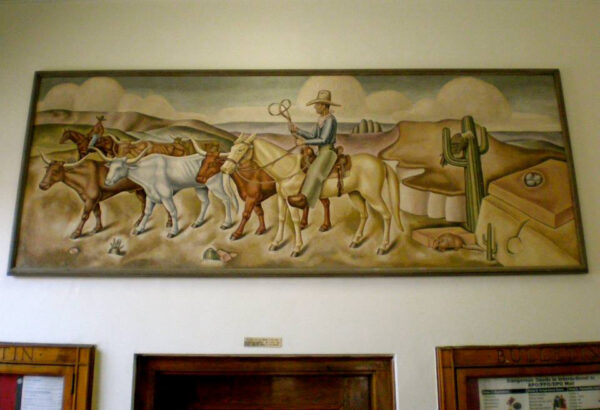This article is part five of a multipart series. Click here to read Part One, Part Two, Part Three, and Part Four
Welcome to the last leg of our tour around Texas through its post office murals. We’ll finish our journey in East Texas.
First, we’ll start in the upper eastern corner of the state in Cooper, which is just half an hour south of Paris, Texas. Cooper is the seat of Delta County and is where one can find Lloyd Goff’s 1939 post office mural, Before the Fencing of Delta County. The mural features a vignette of young, handsome men dressed up as cowboys. I say dressed up because they look like they’re performing a role, temporarily impersonating cowboys. Their hair is perfectly coiffed and, except for a hole in the pants of the gentleman drinking from the bucket, I see no dirt, snags, or stains on their clothes.
The poses feel staged, like a photo shoot. The shirtless cowboy on the left, with his muscular arms among the sea of attractive faces, is probably why some of my colleagues refer to the Cooper composition as “the gay cowboy mural.” The subject matter feels almost reminiscent of a very subdued Tom of Finland piece, with its stereotypically hyper masculine characters set among their working class environment. Looking at other examples of Lloyd Goff’s work produces more examples of compositions with shirtless or nearly naked men at work. And yet, in addition to his figurative work, Goff was also a modernist and produced semi-abstract pieces.
A Dallas artist born and raised, Goff studied with some of the big names in early Texas art like Frank Reaugh, Thomas Stell, and Olin Travis. He also worked with some well-known artists on other public art projects, like Paul Cadmus for the U.S. Embassy in Ottawa, Canada and Reginald Marsh at the Customs House in New York City. Additionally, the young artist traveled around Europe and studied at the Académies Julian and de la Grande Chaumière in Paris. After painting the Cooper mural, Goff studied at the University of New Mexico, Albuquerque for a couple of years, where he later taught, splitting the remainder of his career between New Mexico and New York.
How does the mural’s group of salubrious cowboys relate specifically to Cooper? Historically, the area had been home to the Caddo, Delaware, Quapaw, and Seminole people before Anglo colonial settlers arrived and eventually established the town. Cooper was largely developed by a farming economy dependent on cash crops, first cotton and then wheat. It’s possible that, being an agricultural region, cowboys tending to livestock were a common sight, though there aren’t many details in Goff’s mural that hint at specific ties to Cooper. The landscape itself doesn’t read East Texas, but rather a general area populated by longhorns (note the prickly pear cactus in the lower right corner).
Maybe the reason the mural seems more generic is that it was a reused design Goff had originally submitted for the Dallas post office mural competition. Unfortunately for Goff, the administrators did not find the cowboys of his first sketch to be authentic. They wanted something that represented the more typical “cowboy types and not handsome types of Dude-ranchers.” The Cooper design is Goff’s attempt at “more rugged types.” In my opinion, ain’t nothin’ rugged about these fellas. But apparently the local townsfolk had no qualms, complimenting the mural as “right plain” and “plain natural.”
Next we journey southeast into the threshold of the Piney Woods region of Texas with a visit to Longview. Just 125 miles east of Dallas is where we find Thomas Stell, Jr.’s 1942 mural Rural East Texas in the downtown Longview post office lobby. The painting celebrates East Texas agriculture. At center, just above the doorway, is a farmer driving a tractor with cows standing nearby in front of a log cabin house, and on the left is a pair of horses pulling a cartful of cotton, filled to the brim. Just beyond the farmer in the far distance we see evidence of the lumber industry, with freshly cut logs rolling onto a conveyor belt near what is likely a working sawmill. The painting blends the romantic visions of the rural farm, an ideal of American identity, with the burgeoning values of a modern, industrial country.
Stell grew up over 300 miles south of Longview in Cuero, Texas. Recognized as a talented artist by one of his teachers, the Texas historian Walter Prescott Webb, Stell pursued a career in the arts. From Rice Institute (now Rice University) to the Arts Student League and the National Academy of Design in New York, to Columbia University, his artistic education was extensive. He then imparted some of that education as an instructor at the Dallas Art Institute. Remember Lloyd Goff, whom we just visited in Cooper? He was a student of Stell’s.
When Stell painted the Longview mural, he was actually living in San Antonio, working as the state director of the American Index of Design for the Works Projects Administration and teaching at Trinity University. In fact, the local paper, the San Antonio Light, published an article about professor Stell working on the Longview mural with an accompanying photo of the artist at work.
Though the post office mural doesn’t show off Stell’s strengths as a portraitist, which is what he was best known for, it does exemplify his signature style. His forms are simplified. His boldly contrasting shadows and highlights intensify the curves of the cattle. Every detail is precisely delineated, perhaps a nod to his interest in early Italian Renaissance and Flemish painters. There’s a great clarity in Stell’s draftsmanship. My only question is: what kind of tree is the artist trying to portray in the very left edge of the mural? Is that pine?
We will experience the smooth contours of Stell’s compositions again at our next stop in Teague. If you find yourself in Teague, don’t call attention to yourself as an outsider by incorrectly pronouncing the town name. The locals call it “Tig,” and the town located roughly halfway between Fort Worth and Houston off I-45. Historically, Teague was a railway stop and shipping center for cotton, and like some of the other towns on our journey (we’re looking at you, Ranger), when the cotton boom bottomed out, so did the local population.
Just off the quiet Main Street, across from the quaint public library, visitors will discover Thomas Stell, Jr.’s 1940 mural Cattle Roundup. Like his Longview mural, the Teague composition is clean and simple. However, in this scene we move away from the lush countryside and travel with two cowboys driving a small herd of longhorn through an arid landscape.
The colors are muted. The only vegetation around are a few varieties of cacti. Perched on the large cactus is a vulture. The only other sign of life is a nearby armadillo. The mural is quintessential Texas, but not quite the right region. Why would Stell paint a West Texas scene for a post office located in East Texas? My research didn’t reveal any answers, but it’s clear that the artist is being playful, and the section officials back in Washington, D.C. were none the wiser. For example, despite the fact that they suggested Stell try to be a little more realistic and authentic in his portrayal of the scene, complaining that the horses and cattle were too “toy like,” they completely overlooked the saguaro cactus. Saguaros don’t grow in the Lone Star state!
Now we move deep into the Piney Woods as we make our last stop in Trinity. We started this whole journey with Jerry Bywaters back in Quanah, so it seems fitting to round out our post office adventures with another Bywaters mural. In preparation for the painting, the artist visited a large lumber plant in town — Longleaf Pine Company — to see the mechanics of the operation. His fascination with the process is evident in his 1942 mural, Lumber Manufacturing, which depicts how the workers transform pine logs into board lumber.
Trinity is a tiny town, and is quite off the beaten path, but it’s a sweet, verdant path. The town was named after the nearby Trinity River, which winds its way south into Lake Livingston. At the time of Bywater’s mural, the Longleaf Pine Company, built next to a 37 acre pond, was one of the country’s most successful manufacturers of Yellow Pine. The company was also one of the largest employers in Trinity, so it’s not hard to understand how its closing in 1955 devastated the local economy.
Like his fellow members of the Dallas Nine — a circle of artists in the 1930s and 40s — Jerry Bywaters drew inspiration from nearby surroundings for his subject matter. Likewise, as a follower of Regionalism, Bywaters avoided European abstraction in favor of naturalistic representation, using tight brushwork, a hard-edged style and an earthy palette, as seen in the Trinity mural. Tans, grays, and rusty browns dominate the composition. It’s a very industrial scene, with many clean lines and smooth surfaces. Even the last remaining organic matter — the tree logs — is being scrubbed of its rough exterior.
The study for the mural is in the collection of the Smithsonian, and a comparison shows a few small changes, like the addition of the man working the logs in the right foreground. Through the window of the mill we can see in the background how the nearby environment is being stripped of its natural resources. The painting feels void of life. Or maybe I had a hard time reconciling the mechanized scene of the mural with the lush, tree-lined roads I drove through to reach my destination. Despite my lukewarm response, I still appreciated the artist’s style and attention to detail in representing the hard-working class of men.
I hope it’s been evident that I have a passion for these post office murals. Do I know everything about them? Not even close. Are the murals impartial? No, they’re clearly a product of their time. In fact, a majority of the murals are painted from a white, male perspective, with a few exceptions of female artists, a couple of European artists, and one Mexican artist (side note: of the 850 artists employed throughout the country by the Section of Fine Arts, only ⅙ were women, and only three were African American). But I believe the murals are a good conversation starter, about myriad topics.
I wrote this series not to be the be-all and end-all — there are plenty of great scholars who have authored many wonderful publications on PO murals. Rather, I wrote this series as more of a PSA: There’s some great art out there, sometimes hiding where you least expect it. And I hope these essays have sparked your curiosity to go explore.







3 comments
A truly marvelous 5-part travelogue/artelogue. I’ve really enjoyed this virtual road trip. Thank you!
I photographed 3 PO murals this past weekend in central Texas and reading your reviews has enhanced my enjoyment of tracking them down.
I have thoroughly enjoyed all the post office stories Leslie Thompson has written. The writing is clear and focused, with cogent observations. Yes, Leslie, I can tell that you have a passion for these murals. Thank you for your articles!